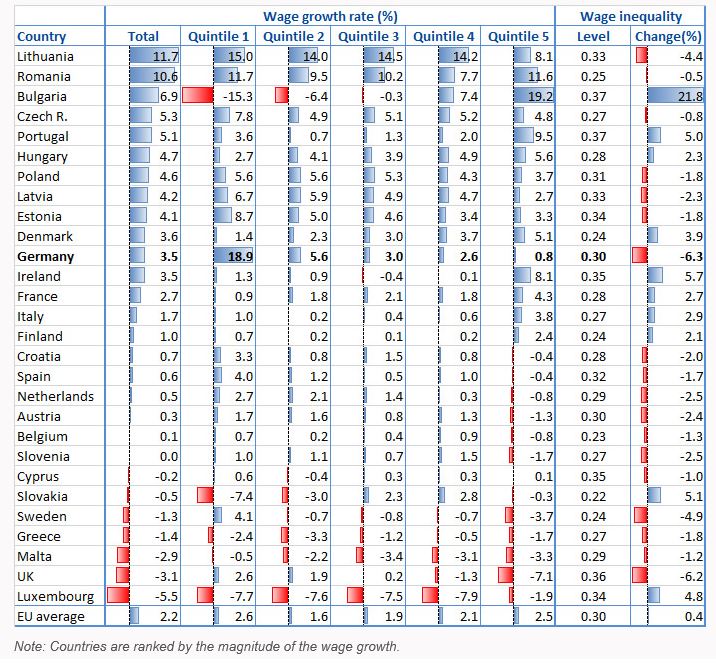UK Almost Bottom of The EU Table Of Wages Growth In 2015
Wednesday 20 June, 2018 Written by Simon Collyer
Wages grew and wage inequality fell in most EU countries in 2015. Germany is not one of the countries where wages rose most, but it did have the largest reduction of wage inequality. Eurofound analysis shows that the German minimum wage policy introduced in 2015 strongly lifted the wages of the lowest-paid employees, particularly those employees who were lower-skilled, younger or working in services.
Wages and wage inequality are a topic of intense debate among academics and policymakers in Europe. Before the crisis, the discussion centred on wage growth below productivity levels and widening pay differentials across the workforce.
More recently, it has turned to big wage declines in some European countries severely hit by the crisis and the sluggish recovery of wages. But analysis of the most recent micro-data from the EU-SILC survey, for 2015, shows a reversal of negative trends in many EU Member States.
Working paper: Wage developments in the EU and the impact of Germany’s minimum wage (PDF)
Wages rise and wage inequality falls
Average real wages increased in more than two-thirds of EU countries in 2015, but there are substantial differences across the region (see the first column in the table below). Wages grew in most eastern European countries and to a much greater extent than in most western European countries, where wage growth was rather subdued or even negative, especially in Mediterranean countries; exceptions were Denmark, Germany, Ireland and France. Similarly, wage inequality declined in around two-thirds of EU countries (see the last column in the table), although there is no significant association between the changes in average wage levels and in wage inequality levels.
Three main patterns emerge from the analysis:
Strong wage growth (4%–12%), mainly due to wages improving more among the lowest-paid employees (quintile 1), causing a fall in wage inequality. We see this pattern in much of eastern Europe – the Baltic countries, the Czech Republic, Poland and Romania – although not in Bulgaria, especially, nor Hungary, where wages grew more among the higher-paid.
More moderate wage growth (1%–3%), mostly due to wage increases among the highest-paid employees, leading to hikes in wage inequality. This is apparent in Denmark, Ireland, France, Italy and Finland.
Wage declines or stagnation (growth of 1% or less) alongside falls in wage inequality generally, mainly due to wage reductions among the highest-paid (Quintile 5). The table shows this pattern in most countries from Croatia down, most significantly in Sweden and the UK.
Germany is similar to the second group of countries because real wages grew significantly (3.5%), although below the rates of eastern European countries. But growth over the wage distribution is completely different in this case: wages increased disproportionately among the lowest-paid employees (by almost 20% in wage quintile 1), which explains why Germany registered the largest reduction in wage inequality among all EU countries in 2015.
Here you can see that the UK is near the bottom of the league table in wage growth, thanks to our government.
Change in average real wages by wage quintile and change in wage inequality, EU Member States, 2015
ABC Note: UK wage growth right at the bottom. In contrast to the UK, Germany's workers having been surveryed are saying that less pess people wwre struggling compared to 2011 when the last survey was done.
ABC Comment. Growing inequality in the UK, what do you think?

Leave a comment
Make sure you enter all the required information, indicated by an asterisk (*). HTML code is not allowed.
Join
FREE
Here











